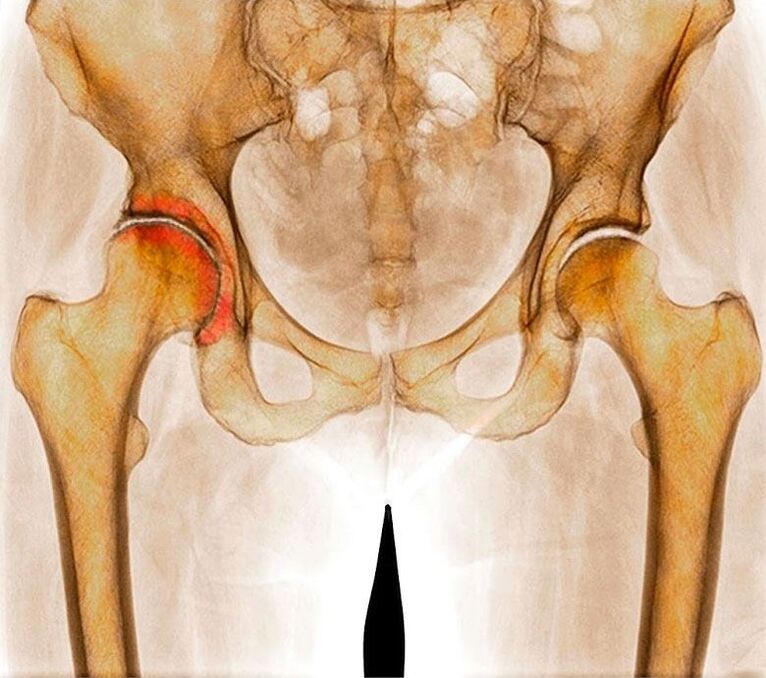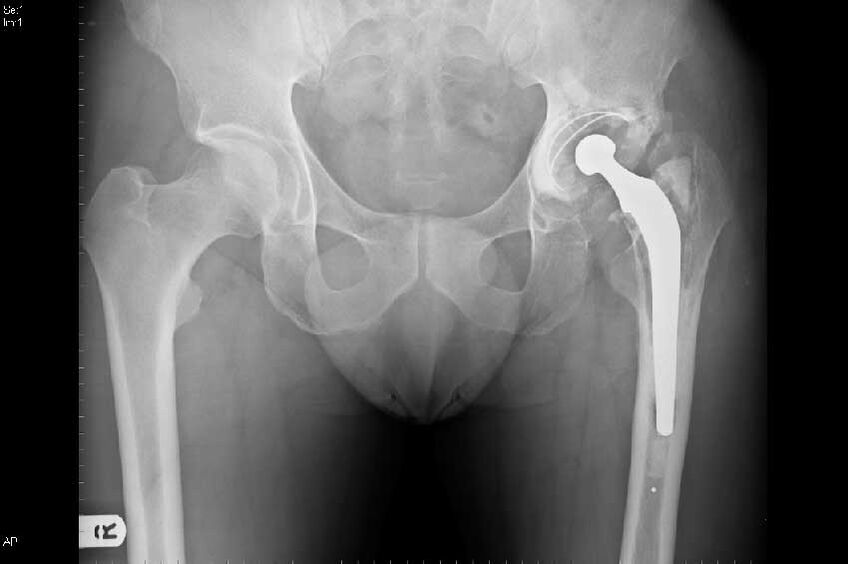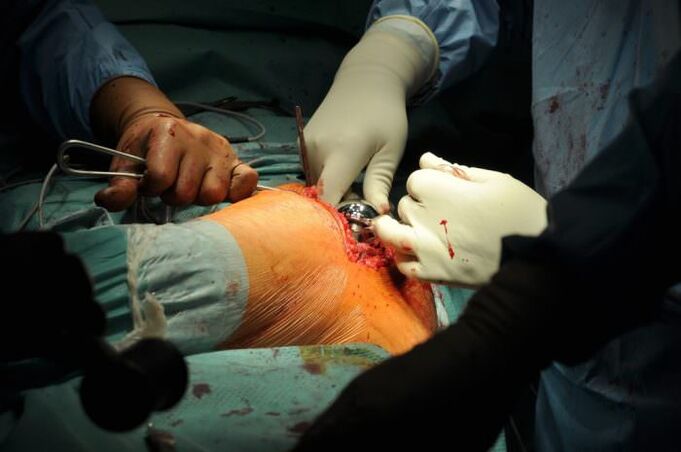What is the arthrosis of the hip joint, what are its symptoms and how to treat it?Arthrosis is a disease that deforms and destroys the joints.Treating hip joint arthrosis is a very long process.In the middle of the last century, Coxartrosis was considered a sentence for the patient, inevitably leading him to an ambulance.But due to the development of medical science, thigh arthrosis can stop, and at the initial stage of the disease to be cured.
What is the arthrosis of the hip union?
Arthrosis is the disease, during which slow destruction and deformation of the joint due to changes in the structure of cartilage tissue occurs.Arthritis is often confused with arthritis, however, these are different diseases, although they may be present at the same time, for example, arthritis arthritis of the hip joint.The difference between arthritis and arthritis lies in the fact that during arthrosis, deformation does not occur due to infectious tissue inflammation, but due to deviations in metabolic processes.

Combined therapy was used-known for the reasons why the pathology was raised helped to determine the correct tactics for the treatment of hip joint arthrosis.When determining how to treat the arthrosis of the hip joint, the attending doctor can focus on both medicines and physiotherapy.The question of surgical intervention can also be raised, if very serious changes have affected the joint of the hip, where the drugs are the base, they will be ineffective.
Causes
Coxarthrosis can be provoked by damage or appear due to advanced age.Coxarthrosis can also be congenital.However, the main risk factors are below:
- diabetes mellitus;
- Hypoteriosis;
- high body weight;
- Poor inheritance (genetic predisposition).
The causes shown can provoke coxartrosis at any age.For risk groups, it is desirable once every six months to undergo preventive examination by a specialist who deals with joint problems.
Interesting!Many people do not know which doctor treats the arthrosis of the hip and other joints, and unconsciously go to the traumatologist.A doctor who can help in this situation is called a arthrologist.
The arthrologist is a profile specialist who knows not only all tactics and medicines for the treatment of arthrosis, but will also be able to choose the types and analogues of these medicines, according to individual indicators.
Arthrosis is often diagnosed in patients over 40 years.The disease develops in stages, three stages are possible to distinguish:
- Deviations occur in metabolism.Is followed by substance synthesis disorders.Cutting the cartilage is worse.
- Due to insufficient nutrition, the cartilage becomes less resilient.It is gradually thinner.Intercepter cleaning is reduced.
- With the thinning of the cartilage, the load on the bone tissue increases and bone deformities occur.
With hip joint arthrosis, degenerative changes in cartilage tissue can only become visible to the patient after years, not immediately at 1 stage.
PHASE
Each of the stages has its own characteristic features.It is important to determine which stage arthrosis of the hip joint, symptoms and treatment at each stage vary in the root.Depending on the stage of the disease, the medication may be prescribed, or surgery.
Medicines are considered effective only in stages 1 and 2. In 3 stages for full cure, surgical intervention is required, otherwise the person remains disabled.
At 1 phase, they can turn the process back, and in transition 1 to 2, and at 2, stop the process of crack destruction and slightly improve the condition of the cartilage tissue.Stage 1 is characterized by the following manifestations:
- Pain manifests itself only in physical loads;
- concentration of pain in the joints;
- The pain goes away after rest;
- Limb mobility is not limited;
- The condition of muscle tissue is normal.
With 1st degree arthrosis, exclusively radiography and tomography are effective.
Phase 2 arthritis is characterized by the following manifestations:
- wandering pain of the thigh area;
- Pain does not leave itself - sedatives of sedatives are required;
- Motor activity is difficult and limited;
- Muscle atrophy is present.
With 2nd degree arthrosis, no hardware research is required - the disease is diagnosed during a visual examination.However, they are directed to MRI and radiographs to determine the deformation sizes.
In 3 stages, arthritis has the following manifestations:
- chronic pain;
- Movement is only possible with a cane;
- A sore limb of smaller length.
Signs of hip joint arthrosis will be implied, and the characteristic symptoms of arthrosis can be completely unexplained.
Characteristic manifestations for arthrosis
Symptoms of arthrosis and its nature depend on the stage of development of pathology.The most pronounced symptom is pain.It may even seem to the patient that he has a thigh neck fracture is so strong pain syndrome.The photo shows that the neck of the thigh and the hip knot is very close.
The arthrosis of the hip joint of the covar and in the early stages can only be taken for fatigue.For this reason, treatment is delayed.Sometimes until the need to replace the joint with an endoprostese, as all the medicines are already powerless.The photo shows an X -ray of the elevator with the options for replacing the joint.

Coxarthrosis mainly gives such types of symptoms:
- Pain syndrome.The main source of pain is difficult to determine.If they appear at rest, you should pay a visit to the arthrologist.
- Some restrictions on the move, light dementia.
- After some time, the injured limb becomes slightly shorter than healthy.
- There are muscle atrophy - diagnosed during palpation.
It is required to use progressive research methods, as hip joint arthrosis does not always give symptoms, it is possible only if there is accurate data.
Treatment of coxarthrosis
After completing the arthrologist inspection and the necessary studies were completed, the doctor decides how to treat the arthrosis of the hip joint.First of all, the disease is assigned ICB Code 10. This facilitates the doctor to choose the right treatment tactics.
Regardless of the selected tactics, treatment is based on 6 basic principles:
- Removal of pain syndrome;
- recharge and restoration of the cartilage;
- improving blood flow to the damaged area;
- decreased articular load;
- strengthening muscle tissue;
- Resetting articular mobility.
In order to achieve all goals, it is customary to use combined therapy.For example, the entire positive effect of using hondoprotectors will be destroyed if the load on the injured node will not reduce the load.Thus, during the treatment of arthrosis, 2-10 approaches are used-it all depends on the severity of the disease and the general indicators of the patient.The most common approaches can be called the following methods:
- The non -steroid group of medication is combined with exercise therapy and other physiotherapeutic measures (massages and others).
- Chondroprotectors combined with hyaluronic acid.It is most often used as restoration therapy.
- Vasodilator drugs can be combined with both chondroprotectors and non -steroidal medicines and exercise therapy.
- Anesthetic ointments can act as an addition to any of other methods of treatment.They themselves do not have a positive effect on union.
- Corticosteroids as intra -articular injections in combination with physiotherapeutic measures.
Hip bands are often used to limit the mobility of the joint.Physiotherapy and non -traditional methods.
Physiotherapy and non -traditional methods

In addition to medication therapy, the patient may need to suffer physiotherapeutic procedures and may even use non -traditional methods as part of treatment.
Interesting!If you follow the principles of a healthy diet and bring your body weight to normal, it is possible to significantly relieve the course of the disease and reduce the severity of the symptoms.
The most common additional procedures that patients with arthritis are:
- Manual therapy lies in the fact that the specialist, using massage techniques, facilitates the course of the disease.
- Exercise therapy (therapeutic gymnastics) - a large number of different options for physical executions that are excellent in the complexity of execution.Helps restore atrophied muscle.
- Folk remedies are most doctors against this method, however, they can consider it as ancillary therapy.With a competent approach, it increases the effectiveness of medication therapy.
- Homeopathy - Official medicine has not proven the effectiveness of homeopathic therapy, however, some patients declare its positive effects and improve the general condition.
- Apityapy is a very controversial technique based on the treatment of bee and the properties of bee venom.
The following procedures are also applied:
- Magnetotherapy is used as auxiliary therapy as well as as an auxiliary measure.Due to the effects of magnetic fields on the human body, blood flow improves and metabolic processes are evaluated.
- Hirudotherapy - due to the ingredients of the ingredients involved in the saliva of the caterpillars, the blood flow and blood enter the atrophied muscle vessels into a larger volume.
- Muddy therapy allows you to bring some nutrients through the skin and has a tonic effect.
- Mummy is used both separately and as part of compresses and tinctures.Official medicine does not deny, but does not confirm a positive effect, everything is based on the patient's individual sensitivity.
- Itself -Meta is used to increase blood flow and lymph flow.Before execution, you should consult an experienced manual therapist or a massage.The specialist will learn the right movements and help process their correct performance.
Mass any additional measure must agree with the participating specialist.
Shades!Traditional medicine, contrary to many statements, is neutral to additional therapeutic measures.However, with their inaccurate performance (for example, sharp movements and strong pressure during themselves), they can worsen the course of the disease.
Some methods associated with non -traditional drug may be contraindicated - an allergic reaction or another negative manifestation is possible after application.
Surgical treatment

In the later stages of the disease, treatment when using traditional and non -traditional medicine methods does not result in the necessary positive result.Operation can be a replacement of the joint, or manipulation with the use of a laser.
Replacing the joint allows you to restore all the motor skills of the joint.The biggest obstacle, with the exception of the high direct cost of the surgeon's work, is not a very significant life.On average, the articular prosthesis requires replacement every 15 years.
Laser therapy for operated coksartrosis is already used when the articular part of the bone is rejected.Thanks to this method, it is possible to remove the damaged area and replace it with an insertion of artificial materials.
Interventiondo Surgical intervention for coxarthrosis is a purely temporary measure.However, if not performed, then with arthritis in 3 phases, people inevitably become disabled without the possibility of normal movement on their own.
PREVENTION
Preventive masses of hip joint arthrosis are based on the elimination of risk factors that can cause coxarthrosis.Preventing coxarthrosis is to follow a healthy lifestyle and respect for general strengthening measures:
- Accept and love an active lifestyle.The biggest risk during pathology is the lack of any movement of the joint - salts are deposited and other complications appear.Light but systematic corners are needed.
- Follow your diet.You need to adhere to such an energy style so that there are no weight problems.However, from using a large amount of table salt in the dishes, it is necessary to adhere.It also applies to sharp and spicy dishes.Food should be complete and contain all the necessary micro and macro elements.
- Do not neglect planned medical examinations - this will detect the disease at an early stage.
- To prevent hypothermia - such a negative effect can cause inflammatory processes in the joints and lead to arthrosis.
If you suspect coxartrosis, you should not try to make a diagnosis yourself.Even an experienced doctor may not always be at first glance and only after a patient's study to say accurately and confidently that this is exactly coxartrosis.And even more, a standalone therapy recipe is unacceptable - at least one medicine, at least every other.Insufficient awareness of the effect on the body and possible side effects can lead to sad consequences.





































